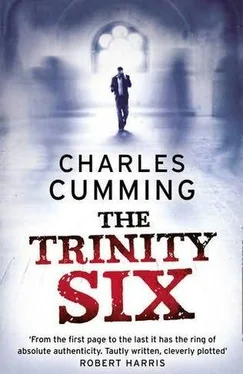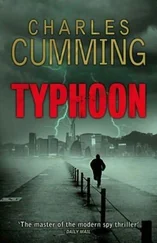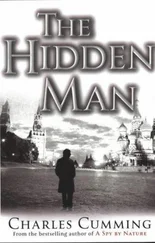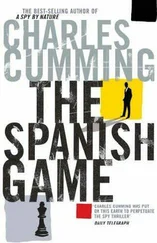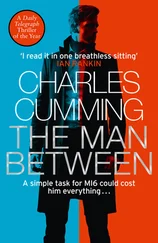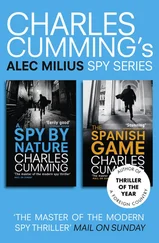Charles Cumming - The Trinity Six
Здесь есть возможность читать онлайн «Charles Cumming - The Trinity Six» — ознакомительный отрывок электронной книги совершенно бесплатно, а после прочтения отрывка купить полную версию. В некоторых случаях можно слушать аудио, скачать через торрент в формате fb2 и присутствует краткое содержание. Жанр: Шпионский детектив, на английском языке. Описание произведения, (предисловие) а так же отзывы посетителей доступны на портале библиотеки ЛибКат.
- Название:The Trinity Six
- Автор:
- Жанр:
- Год:неизвестен
- ISBN:нет данных
- Рейтинг книги:5 / 5. Голосов: 1
-
Избранное:Добавить в избранное
- Отзывы:
-
Ваша оценка:
- 100
- 1
- 2
- 3
- 4
- 5
The Trinity Six: краткое содержание, описание и аннотация
Предлагаем к чтению аннотацию, описание, краткое содержание или предисловие (зависит от того, что написал сам автор книги «The Trinity Six»). Если вы не нашли необходимую информацию о книге — напишите в комментариях, мы постараемся отыскать её.
The Trinity Six — читать онлайн ознакомительный отрывок
Ниже представлен текст книги, разбитый по страницам. Система сохранения места последней прочитанной страницы, позволяет с удобством читать онлайн бесплатно книгу «The Trinity Six», без необходимости каждый раз заново искать на чём Вы остановились. Поставьте закладку, и сможете в любой момент перейти на страницу, на которой закончили чтение.
Интервал:
Закладка:
Two days later, Gaddis drove the short journey from his house in Shepherd’s Bush, via Chiswick, to the National Archives, a complex of buildings in Kew which stores official government records. At the enquiries desk he made a formal request for Crane’s war record and ran Crane’s name through the computerized database. The search produced more than five hundred results, most of them relating to Edward Cranes born in the eighteenth or nineteenth centuries. Gaddis tried ‘Thomas’ and ‘Tommy’ and ‘Tom Neame’ but found only the Medal Card of a Thomas Neame who had been a private in the Welsh Regiment and Army Service Corps between 1914 and 1920. The wrong generation. Another dead end.
Finally, he got lucky. A National Archives assistant directed Gaddis to the Foreign Office Lists, which comprised several shelves of well-thumbed hardback volumes in burgundy leather containing basic biographical information about employees of the Foreign Office. He picked up the volume marked ‘1947’ and began searching the Statement of Services for the surname ‘Crane’. What he saw almost brought him to his feet with relief. Here, at last, was concrete proof of ATTILA’s existence. CRANE, EDWARD ANTHONY Born 10 December 1916. Educated at Marlborough College, and Trinity Hall, Cambridge. Granted a Certificate as 3rd Secretary in the Foreign Office, 11 October 1937, and appointed to the Foreign Office, 17 October 1937. Transferred to Athens, 21 August 1938. Transferred to the Foreign Office, 5 June 1940. Promoted to be 2nd Secretary, 15 November 1942. Transferred to Paris, 2 November 1944. Promoted to be an Acting 1st Secretary, 7 January 1945.
He went back to the shelves and drew out the List for 1965, which was the last available volume before the Foreign Office records were computerized. By then, Crane had served all over the world but, as the obituary confirmed, had never been promoted to ambassador. Why? Did it have something to do with the fact that Crane had never married? Was he homosexual, and therefore — back in those days — regarded as unreliable? Or had the government, in the wake of Burgess and Maclean, developed suspicions about Crane’s links to Soviet Russia?
Charlotte had told Gaddis that Crane had been known to the Ring of Five, so he picked up the volume for 1953. When he found what he was looking for, he experienced that particular buzz to which he had been addicted for more than twenty years: the thrill of history coming alive at his fingertips. BURGESS, GUY FRANCIS DE MONCY Born 16 April 1911. Educated at Eton College, and Trinity Hall, Cambridge. Granted a Certificate for Branch B of the Foreign Service 1 October 1947 and appointed with effect from 1 January 1947 to be an Officer, Grade 4. Transferred to Washington as 2nd Secretary, 7 August 1950. Suspended from duty, 1 June 1951. Appointment terminated 1 June 1952, with effect from 1 June 1951.
Donald Maclean was included in the same volume: MACLEAN, DONALD DUART Born 25 May 1913. Educated at Gresham’s School, Holt, and Trinity Hall, Cambridge. M. 1940, Melinda Marling. Granted a Certificate as 3rd Secretary in the Foreign Office or Diplomatic Service, 11 October 1935, and appointed to the Foreign Office, 15 October 1935. Transferred to Paris, 24 September 1938. Transferred to the Foreign Office, 18 June 1940.
This last detail caught Gaddis’s eye. Crane had also been posted back to London in June 1940. Had he worked alongside Maclean? Were the two men friends?
The entry continued: Promoted to be a 2nd Secretary, 15 October 1940. Transferred to Washington, 2 May 1944. Promoted to be an Acting 1st Secretary, 27 December 1944. Promoted to be a Foreign Service Officer, Grade 6, 25 October 1948, and appointed Counsellor at Cairo, 7 November 1948. Transferred to the Foreign Office and appointed Head of American dept., 6 November 1950. Suspended from duty, 1 June 1951. Appointment terminated 1 June 1952, with effect from 1 June 1951.
The same phrases. ‘Appointment terminated.’ ‘Suspended from duty.’ 1951 had marked Burgess and Maclean’s flight from England. Two of Her Majesty’s brightest stars escaping to Moscow aboard a cross-Channel ferry on a cold spring morning, tipped off — by their fellow traitors, Kim Philby and Anthony Blunt — that MI5 had exposed them as agents of the KGB.
Gaddis now looked for Philby’s name, under ‘P’ in the Statement of Services. Nothing. He picked up the Foreign Office List from 1942 and drew the same blank. Gaddis checked the volume for 1960. Again, no mention of Philby. Why had he not been included in the list of Foreign Office employees? Did MI6 officers enjoy anonymity? Gaddis began to go through every volume of the List, from 1940 to 1959, finding no reference to Philby at any stage. Instead, he stumbled upon an anomaly: Edward Crane’s listings disappeared between 1946 and 1952, the period in which The Times obituary had placed him in Italy. Had he joined MI6 during this period? Or had Crane taken an extended, post-war sabbatical? There were so many questions; too many, if Gaddis was honest with himself. To research a story on this scale, to do justice to Charlotte’s book, would take years, not months. There were historians who had dedicated their lives to the search for the sixth man; none of them had been successful. If only he could track down a surviving employee of the Foreign Office who might have known Crane. Surely there was a colleague who had sat on the same delegation or attended a conference at which Crane had been present?
Towards midday he walked downstairs, ate a tasteless cheese sandwich at the National Archives cafe and took a seat at a public Internet terminal. He had one more line of enquiry: a colleague at UCL had tipped him off that senior diplomats often deposited their papers and private correspondence in the archive at Churchill College, Cambridge. Gaddis might find a cross-reference between Crane and, say, a retired British ambassador to Argentina, or a 1st Secretary in Berlin. Seagulls were clacking outside as he typed ‘Churchill College, Cambridge’ into Google. He pulled up the Janus webserver at Cambridge and typed ‘Edward Crane’ into the search bar. Three catalogue entries came up, none of which made specific reference to Crane. When he typed in ‘Thomas Neame’, the server returned no results at all.
It was hugely frustrating. He went out to the car park, found an old packet of Camels in the glove box of his car and abandoned his latest attempt to quit. The cigarette did little to ease his mood and he drove back to Shepherd’s Bush under light autumnal rain. It was as if all mention of Crane and Neame had been deliberately and methodically erased from the historical record. Why else was it proving so difficult to track them down? He had never known such slow progress on the early stages of a project. Locked in heavy traffic on the M4, Gaddis made a decision to take a flight to Moscow and to approach Crane from the Russian side. If ATTILA was a prized KGB asset, as Charlotte had claimed, somewhere in the vaults of Soviet intelligence there would be a file on Edward Crane. Whether or not, in the wake of Tsars, he would be granted access to the files by the Russian authorities was a different matter altogether.
Chapter 11
Ordinarily, the activities of an anonymous London academic conducting research at the National Archives in Kew would not have been drawn to the attention of the head of the Secret Intelligence Service. But Edward Crane was no ordinary spy. When Gaddis had made a formal request for his war record, an automated alert had been sent from Kew to Sir John Brennan’s private office at MI6 headquarters. When Gaddis had then typed ‘Edward Crane’ and, minutes later, ‘Thomas Neame’ into Google on a public computer, a second automated message had flashed up at Vauxhall Cross. Within an hour, Brennan’s secretary was placing a report on his desk. PERSONAL FOR C / GOV86ALERT / 11-1545-09 Samuel Gaddis, Doctor of Russian History at UCL School of Slavonic and East European Studies (SSEES), made a formal request this morning at NA/KEW for the war record of Edward Anthony Crane. Alert shows that a member of the public, also thought to be Gaddis, later conducted separate, related Google searches on a public computer at NA/KEW for ‘Edward Crane’ and ‘Thomas Neame’.
Читать дальшеИнтервал:
Закладка:
Похожие книги на «The Trinity Six»
Представляем Вашему вниманию похожие книги на «The Trinity Six» списком для выбора. Мы отобрали схожую по названию и смыслу литературу в надежде предоставить читателям больше вариантов отыскать новые, интересные, ещё непрочитанные произведения.
Обсуждение, отзывы о книге «The Trinity Six» и просто собственные мнения читателей. Оставьте ваши комментарии, напишите, что Вы думаете о произведении, его смысле или главных героях. Укажите что конкретно понравилось, а что нет, и почему Вы так считаете.
